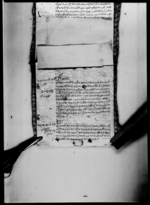A copy of a lālamohara from King Rājendra appointing Lakṣmīnātha Bhaṭṭarāī as caretaker of the guṭhī attached to Śrī Kālikā of Gorkhā (VS 1889)
ID: K_0016_0028B
Edited and
translated by Astrid Zotter
Created: 2021-01-18;
Last modified: 2023-03-06
For the metadata of the document, click here
The accompanying edition, translation/synopsis and/or commentary are available under the terms of the Creative Commons Attribution-ShareAlike 4.0 International License
Abstract
This copy of a lālamohara from the king, who according to the date must have been Rājendra, appoints Lakṣmīnātha Bhaṭṭarāī to follow Kālu Thāpā as caretaker of the guṭhī [lands] at Purkoṭ for regular and occasional worship of Kālikā of Gorkha.Diplomatic edition
[1r]
1⟪नं∙७७⟫1पो१८पां११९सी५११1पुजाहारी2हे∙ना∙रा∙वीष्णु
3भंनौहर्ष1आगेलक्ष्मी∙नाथभट्टराईके∙गोर्षाश्रीकाली∙काका∙पुर्कोट्कोपुजा
2गुठीकोकालुथापाकानाऊकोमोहरहानी∙तीमीलाईवक्स्यौं∙आफना
3षातीर∙जामासीतपरापुर्व∙देषीचलीआय़ा∙कोनीत्यनैमीत्तीकपु
4जाचलाईहाम्रोजये़मनाईसेषवाकीरहनाकोलीगुठीजानीभोग्यगर
5ईतीसंम्वत∙१८८९साल∙फागुणवदी८रोज३सु¯¯¯¯¯¯¯¯¯[Unknown seal][Unknown seal]
Translation
[1r]
No. 771
Bundle (po[kā]) 18, pāṃ 119, sī 5112
[Concerning] a pūjāhārī
The one who watched [was] Deputy (nāyaba) RāiṭaraVīṣṇu.3
The one who said [was] the nau[sindā]Harṣa.
We have annulled the mohara [issued] in Kālu Thāpā's name for the guṭhī [supporting] worship (pūjā) [with landholdings] at Purkoṭ belonging to Śrī Kālikā of Gorkhā and have granted it to you. Being mindful of your duties, manage the regular and occasional worship rituals that have been performed since olden times, celebrate our triumphs, take what is remaining [after the expenses for worship have been covered], conceive the guṭhī [as yours] and enjoy [the attendant fruits].
Tuesday, the 8th of the dark fortnight of Phālguna in the [Vikrama] era year 1889 (1833 CE).4 Auspiciousness.
[Unknown seal]
[Unknown seal]
Commentary
The present document has to do with the management of the guṭhī related to the worship of Śrī Kālikā, the main deity of Gorkha Palace. This guṭhī was established by the king's grandmother, Kāntavatī Devī, in VS 1856 (1799 CE) and controlled 1,300 murīs of land in Purkoṭa in the district of Tanahu (see K_0120_0020).
The document appoints Lakṣmīnātha Bhaṭṭarāī to follow Kālu Thāpā as being in charge of the guṭhī. A year later, in Pauṣa VS 1890, Lakṣmīnātha was followed by PurohitaHemalāla (K_0003_0035C). According to the Sanskrit text of the founding copperplate (K_0120_0020), where the post is called adhikārī, the person appointed would have to protect the guṭhī land at Purkoṭa and see to it that the items specified in the corresponding dānapatra (reissued in VS 1942 after becoming unreadable; see K_0120_0024) were provided from its produce and brought to Gorkha. Furthermore, he would have to inform state authorities in case the items could not for some reason be provided.
For more details about the guṭhī, see the related documents K_0120_0020, K_0120_0021, K_0120_0024, K_0020_0007B, RRC_0009_0002, K_0015_0022B and K_0003_0035C.

